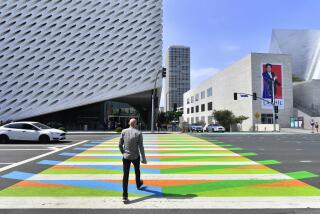Does L.A. need another downtown?
DON’T HATE ME, Eli Broad. I’m just asking the question here: Do we really need a new downtown?
By which I mean a premeditated “center,” a ready-made downtown, the kind that the city and county of Los Angeles officially sealed with big smoochy votes that greenlighted the Grand Avenue project on the day before Valentine’s Day, an edificial sweetheart deal to create a once-and-for-all heart of the city.
Isn’t that heart beating already? At least a couple of chambers’ worth? We have the Latino shopping downtown; the Little Tokyo downtown; the arts downtown of the Diz and MOCA; the historic, lofty downtown; the ‘60s redevelopment/skyscraper downtown; the Staples/L.A. Live/Convention Center downtown.
Tom Gilmore, the developer who has done much good, and I hope has also done well administering some of the civic CPR that’s revived the historic downtown, told me he believes that “downtown is and should be plural. I’m concerned that the city will focus all of its energy on the marquee projects and forget about the bread-and-butter development happening throughout downtown.” Like chemotherapy, he thinks, if the Grand Avenue project doesn’t kill downtown, it will make us better.
Look — and I don’t often ask this of Angelenos — at New York City. Where is its downtown, its center? Wall Street? Central Park? Soho? Nobody could tell you where the heart of New York City is. Why insist on something different from L.A.? We’re way past having to choose between a Stepford CityWalk downtown and a step-over-the-urine skid row downtown.
The unanimous vote of the City Council, and the votes of all but one of the county supervisors, handed over a civic candy box to the Grand Avenue developers. The bonbons included public land leased for private, commercial use, along with a rich, creamy filling of tax breaks (please don’t tell former Councilman Joel Wachs, it’d break his frugal heart) of disputed degrees of largesse — from a low-ball $40 million to the city analyst’s $66 million — over 20 years.
What we get for this, over time, is a mixed-use model of glam, spanking-new buildings and vistas along the old Bunker Hill spine — including two Frank Gehry towers, one with 1,000 condos (one in five of them low income) and one for a five-star hotel chain whose ads show moguls and movie stars looking relaxed and pampered; in all, about 80 vertical acres of development.
From Grand Avenue, a 16-acre park will tumble down from the hilltop to City Hall, an area that is now a dispiriting tier of government blocks occupied by a desolate “civic plaza” of flagpoles, a forlorn Starbucks and parking lots. I imagine something like the Mall in Washington — but I worry that the developers are imagining something like a mall in Tarzana.
Grand Avenue is really a re-re-re-redevelopment, which began many decades ago when Bunker Hill went from swank to rank. They shaved off the hilltop in the 1960s and built the Music Center, and that was supposed to be the new heart and soul of downtown.
What’s a downtown for, anyway? It’s usually a place where people can get and do what they can’t get and do elsewhere in the city. In the 1920s, thousands of electric cars left downtown every day for the suburban reaches of Southern California, bringing people from Riverside and Long Beach to shops and entertainment they couldn’t find in their own burgs.
Now they can, of course. Big-screen TVs and iPods create audiences of one. And nearly every suburban city and neighborhood replicates the chain-store commerce of the next one, which proves that, like certain actresses and the Botox needle, the risk lies in too much as well as in too little. No one is going to travel from the San Fernando Valley to 1st Street for the same Pottery Barn experience that’s available 10 blocks from home. If you’ve seen one Gap .
Downtowns are made by demography more than by geography. Someone once said — oh wait, it was me — that L.A.’s essential character has always been suburban, back to the days of missions and land-grant ranchos. What was a rancho but a mini-suburb, a self-sustaining townlet feeding and entertaining and supporting itself? A man could ride from rancho to rancho then, as he drives the freeways today from Chatsworth to Whittier, without bothering too much about what lies in between.
The day I knew to a dead-bang certainty that downtown was already back was when I was crossing a street on the way to a restaurant. Walking toward me, in the crosswalk, was a couple with skis over their shoulders and ski boots in hand. I looked around for the cameras that had to be shooting a chewing gum or beer commercial — that’s a lot of what downtown has been for ages, Hollywood’s ready-made back lot.
No cameras. I had to ask them: “Were you are you do you?”
Yep, they said. We’ve been skiing. And we’re coming back home. To downtown.
More to Read
Start your day right
Sign up for Essential California for news, features and recommendations from the L.A. Times and beyond in your inbox six days a week.
You may occasionally receive promotional content from the Los Angeles Times.







